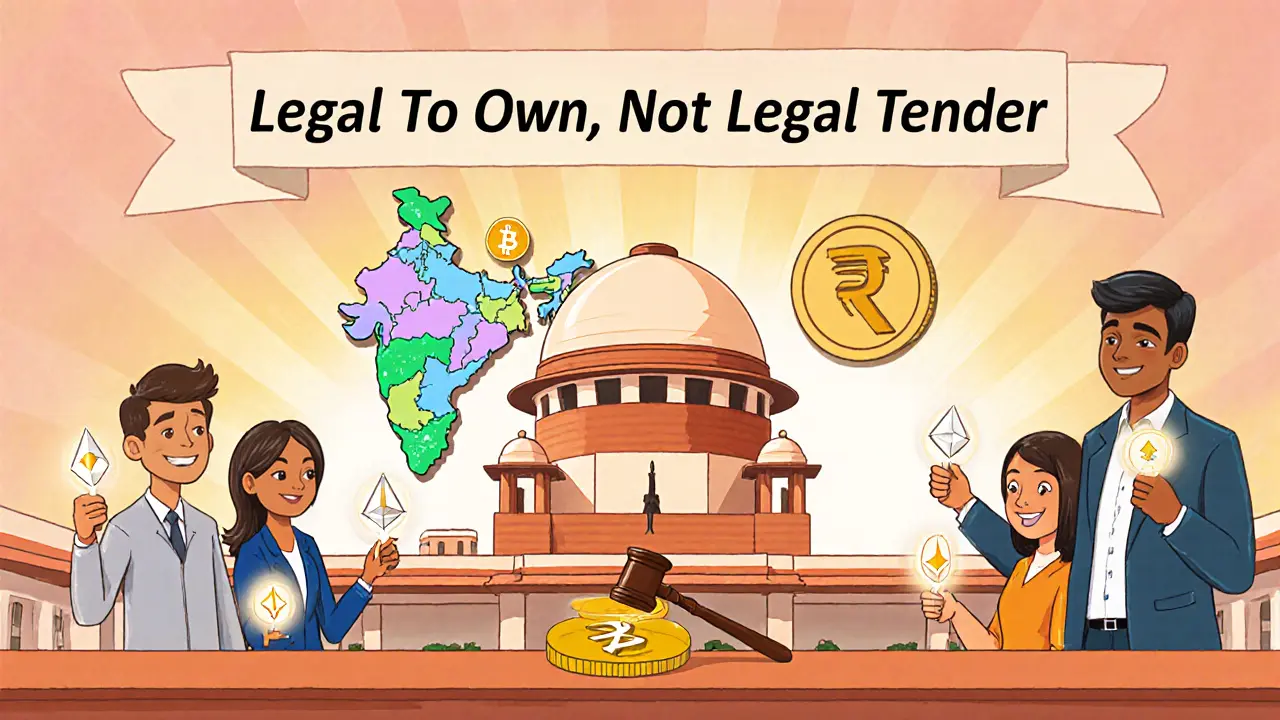India Crypto Tax Calculator
Tax Calculation Tool
Calculate your tax liability for cryptocurrency transactions in India based on current regulations (30% income tax, 1% TDS, and 18% GST).
Quick Takeaways
- India calls crypto assets “Virtual Digital Assets” (VDAs) - legal to own and trade, but not legal tender.
- Supreme Court’s 2020 ruling restored banking access after the 2018 RBI ban.
- Flat 30% income‑tax on VDA gains plus 1% TDS and 18% GST makes the effective tax burden >49%.
- Four agencies oversee the space: RBI, Ministry of Finance, FIU‑IND, and SEBI (since 2025).
- Future regulation may arrive via a discussion paper and a dedicated crypto bill, but the core stance is unlikely to change soon.
How India Defines Crypto Assets
In Indian law, the term Virtual Digital Assets (VDAs) replaces the generic phrase “cryptocurrency.” A VDA is any digital representation of value that can be transferred, stored, or traded electronically, but it does not have the status of legal tender. The definition was codified after the Supreme Court’s 2020 decision and now sits under the Income Tax Act, 1961, and the Prevention of Money Laundering Act (PMLA).
Because VDAs are not legal tender, they cannot be forced upon a creditor to settle debts. Only the central bank digital currency (digital rupee) issued by the Reserve Bank of India (RBI) enjoys that status.
Historical Timeline of Crypto Regulation in India
- 2013‑2017: RBI issues three public cautions warning about the risks of virtual currencies.
- April 6, 2018: RBI circular titled “Prohibition on dealing in Virtual Currencies” bans banks and NBFCs from supporting crypto‑related activities.
- March 2020: Supreme Court of India overturns the 2018 ban in Internet and Mobile Association of India v Reserve Bank of India, restoring banking services for crypto firms.
- 2022‑2023: Ministry of Finance introduces a flat 30% tax on VDA gains; FIU‑IND makes registration mandatory for all VDA service providers.
- April 1, 2025: Securities and Exchange Board of India (SEBI) begins oversight of tokens that exhibit security characteristics.
- July 7, 2025: Bybit applies an 18% GST on all crypto‑related services, pushing the effective tax rate above 49%.
Current Regulatory Framework
Four bodies share responsibility for crypto activities:
- Reserve Bank of India (RBI) - monitors systemic risk, issues policy guidance, and enforces that private crypto cannot become legal tender.
- Ministry of Finance - drafts tax rules, publishes annual finance bills, and oversees the broader fiscal impact of VDAs.
- Financial Intelligence Unit‑India (FIU‑IND) - implements AML/KYC requirements under the PMLA; all exchanges must register and submit periodic reports.
- Securities and Exchange Board of India (SEBI) - applies securities law to crypto tokens that function like shares or bonds.
The overlapping jurisdictions create a compliance maze: a crypto exchange must simultaneously satisfy RBI’s stability guidelines, FIU‑IND’s AML checks, SEBI’s securities reporting (if applicable), and the Ministry’s tax filing obligations.
Taxation Regime - Numbers You Need to Know
India’s crypto tax policy is among the toughest worldwide. The key components are:
| Component | Rate | Applicable To | Notes |
|---|---|---|---|
| Income Tax on Gains | 30% | All profit from VDA sales, swaps, staking rewards | No cost‑of‑acquisition deductions, flat regardless of holding period |
| Tax Deducted at Source (TDS) | 1% of transaction value | Every VDA transfer above ₹10,000 | Paid by the party executing the transfer; creditable against final tax |
| Goods & Services Tax (GST) | 18% | All crypto‑related services - trading, margin, staking, withdrawals | Levy applied by the service provider; adds to effective tax burden |
| Combined Effective Rate (High‑Volume Trader) | ≈49%+ | Traders with frequent high‑value transactions | Sum of 30% income tax, 1% TDS, and 18% GST (non‑deductible) |
These taxes are collected by the government through the exchange’s compliance layer. Failure to report gains can trigger penalties under the Income Tax Act and the PMLA.

What It Means for Users and Businesses
For an individual investor, the practical steps are:
- Maintain a detailed ledger of every buy, sell, swap, and staking reward.
- Calculate net gains per transaction; apply the 30% flat rate.
- Ensure the exchange deducts 1% TDS on qualifying transfers and provides a Form‑26AS receipt.
- Include GST paid on service fees when filing annual returns (though it is not creditable).
Businesses that operate exchanges, wallets, or crypto‑related services face tougher obligations:
- Register with FIU‑IND and implement real‑time AML monitoring.
- Act as TDS collectors for all outbound VDA transactions above the threshold.
- File periodic GST returns for each service category.
- If the platform issues tokens that resemble securities, submit prospectus‑style disclosures to SEBI.
These compliance costs have pushed many smaller players out of the Indian market, consolidating activity around well‑capitalised domestic exchanges like WazirX, CoinDCX, and a few global platforms that have set up Indian subsidiaries.
Future Outlook - Where Is India Heading?
Several developments could reshape the landscape:
- Discussion paper (2025): The government promised a public consultation on a dedicated crypto law. Topics expected include DeFi regulation, staking reward treatment, and custody licensing.
- FSB peer review (October 2025): International recommendations may nudge India toward tighter AML standards and clearer token classification.
- Potential crypto‑specific legislation: Analysts predict a bill that codifies VDA definitions, streamlines tax reporting, and creates a tiered licensing regime for exchanges, custodians, and lending platforms.
- Digital rupee rollout: As RBI pushes the CBDC, it may incentivise users to shift away from private VDAs, especially for everyday payments.
While the core stance-legal to hold, illegal to use as legal tender-will likely stay, we can expect finer granularity in how different token types are taxed and supervised.
Frequently Asked Questions
Is it illegal to own Bitcoin in India?
No. Bitcoin and other VDAs are legal to own, buy, sell, and trade. The only restriction is that they cannot be used as legal tender for settling debts.
Do I have to pay tax on every crypto transaction?
You pay 30% income‑tax on the profit from each transaction. Additionally, a 1% TDS is deducted on the transaction value when it exceeds the RBI threshold, and an 18% GST is charged on the service fees.
Which government agency regulates crypto exchanges?
Exchanges must register with FIU‑IND for AML compliance, follow RBI guidelines for financial stability, and, if they issue security‑like tokens, comply with SEBI regulations.
Can I use crypto to pay for groceries?
Technically yes, if the seller agrees, but because crypto is not legal tender, you cannot force a merchant to accept it, and the transaction would still be subject to tax reporting.
What is the difference between a VDA and the digital rupee?
A VDA is a private digital asset like Bitcoin, treated as a taxable investment. The digital rupee is a central bank digital currency (CBDC) issued by the RBI and has legal‑tender status.


Comments
Anjali Govind
India’s crypto tax regime is definitely a maze.
October 12, 2025 AT 09:22
Sanjay Lago
The current framework imposes a flat 30% income tax on crypto gains, a 1% TDS on sell‑side transactions, and an 18% GST on service fees. This stacked structure pushes the effective tax rate well above 40% for active traders. It also means you have to file quarterly TDS returns if you’re dealing in large volumes. Keeping detailed transaction logs is the only way to avoid surprise notices.
October 17, 2025 AT 06:02